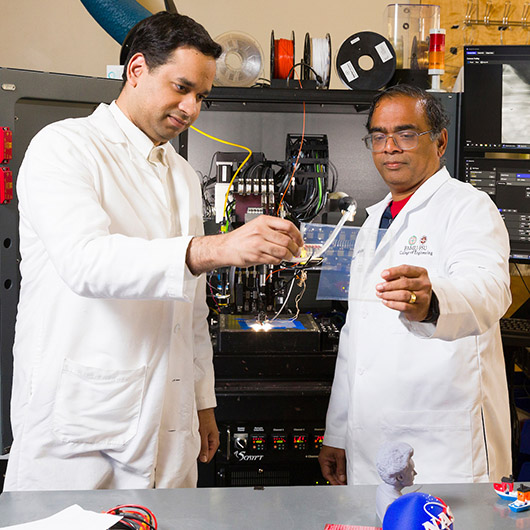

Research Terms
Engineering Industrial Engineering Manufacturing Engineering
Keywords
Additive Manufacturing Composites Famu-Fsu College Of Engineering Multifunctional Composites Nanomaterials Non-Metal Conductor Printed Sensors Sem/Tem Analysis Thermal Protection System (Tps)
Industries
Industrial Engineering Manufacturing Engineering
The present invention describes a carbon-materials-based membrane electrode assembly (MEA) for a fuel cell comprising a catalyst layer.
The catalyst layer can include a plurality of catalyst nanoparticles, e.g., platinum, disposed on buckypaper. A particular feature of the MEA, according to the invention, is that the buckypaper film is fabricated with carbon nanotubes, nanofibers, or a mixture thereof, with little or no binder. The buckypaper additionally can be treated with high temperature for improving electrical and/or mechanical properties of the structure. The microstructure of the buckypaper can be tailored by adjusting the starting materials and nanotubes dispersion so as to achieve a desired porosity, pore size, surface area, and electrical conductivity for use as the catalyst layer of the MEA. The catalyst nanoparticles are preferably deposited directly at the most efficient sites of the buckypaper to thereby maximize the three-phase reaction coefficient.
The MEA so fabricated can have a higher catalyst utilization rate at the electrodes, can provide higher power output, and can have enhanced oxidation resistance, and well as a longer service life, as compared to conventionally-fabricated fuel cells.
This present invention describes a novel technique to fabricate carbon nanotube or nanofiber thin films (buckypapers)/solid electrolyte actuator devices for lightweight, high performance actuator and morphing structure applications. The method includes two nanoscale fiber films adjacent to a solid polymer electrolyte positioned at least partially in between. Moreover, the solid polymer electrolyte is affixed to the two nanoscale fiber films. The nanoscale fiber films may be buckypapers made of carbon nanotubes. The actuator is capable of dry actuation.
This new approach to prepare buckypaper actuators can eliminate the need to use insulation layer in structures and retains high concentration and conducting of nanotube networks in the actuators, which are critical to achieve high performance actuation. More importantly, all the actuators can work properly in open air, which is critical for real-world applications. High nanotube loading and good conducting networks in buckypapers lead to improved actuation performance. Furthermore, the actuator can be easily laminated or encapsulated with polymer films or coating to resist environmental effects. Through improvements of nanotube dispersion, alignment and conductivity of buckypapers, we can further enhance and optimize actuation performance. The invention is a technical breakthrough to realize real-world engineering applications of nanotube-based actuators. The invention overcomes the major technique barriers, such as working in liquid electrolyte and lower performance, of current liquid electrolyte and nanotube/polymer mixture-based actuator systems.
Due to exceptional high mechanical properties and lightweight of carbon nanotube and nanofiber materials, lightweight and high performance actuation can be expected for both immediate and near future engineering applications, such as morphing structures of aircraft and nanoscale/microscope actuators for device applications (for instance, actuators for driving microscale).
The present invention describes a method of creating lightweight efficient parabolic solar panels and a unique approach to realize improved alignment of nanotubes in buckypaper materials.
This invention provides a new method to align carbon nanotubes in buckypapers by stretching thermoplastics/buckypaper films. Buckypaper is a thin film (approximately 20µm) of nanotube networks, which can be utilized in various products, such as composites, electronic devices and sensors. Since nanotubes are highly anisotropic in nature, the alignment of nanotubes in buckypaper is critical for achieving high mechanical performance and high electrical and thermal conductivity.
This invention provides a novel technique to enhance carbon nanotube dispersion and interfacial bonding in epoxy-based nanotube nanocomposites through in-situ polymerization. The in-situ polymerization reaction grafts peroxide groups onto the surfaces of nanotubes and the functionalized carbon nanotubes or nanofibers react with epoxy resin during nanocomposites fabrication. This in-situ polymerization can lead to high-exfoliation and uniform dispersion of carbon nanotubes or nanofibers in the epoxy polymer matrix during modification of nanotube surface characters. Furthermore the in-situ reaction produces covalent bond between nanotubes or nanofibers and the epoxy polymer matrix during composite fabrication through drafted peroxide groups to substantially improve load-transfer between nanotubes and resin. The significantly improved dispersion and interface bonding considerably increase the load-transfer and acquire high performance.
Carbon nanotubes are ideal for polymer matrix composites due to their mechanical and electrical properties. However, to date, the overall properties of CNT-polymer composites have not reached their full potential due to poor dispersion and low concentrations of CNTs. Our new scalable process yields high-CNT content (60 wt%) polymer composites using a simple, three-step process:
These improved polymer composites are ideal for defense applications and deep space exploration.











































